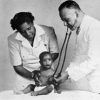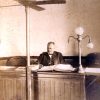calsfoundation@cals.org
Burton-Aikin Feud
The Burton-Aikin (also spelled “Aiken”) feud between Dr. Phillip Patrick (known as P. P.) Burton and Dr. Trent C. Aikin—who both practiced medicine in Batesville (Independence County )—began on October 21, 1841, with the death of Nicholas E. Burton (son of P. P. Burton) and ended on September 15, 1849, when an Independence County jury found P. P. Burton’s son Phil Burton “not guilty” in the murder of Dr. Aikin.
The feud grew out of a medical disagreement between the two doctors. Dr. Aikin was called to treat a “Negro woman” (presumably a slave) belonging to a Mr. Byers of Batesville. Aikin diagnosed the woman with liver disease and began treatment of it. When the woman failed to improve, Byers asked Dr. Burton for a second opinion. Burton, according to local historian A. C. McGinnis, “decided at once that a wrong diagnosis had been made; that the patient had no diseased liver and rendered a prognosis of death on account of the malpractice to which she had been subjected. The woman did die, and a post-mortem examination supported Dr. Burton’s findings.”
Aikin thought his reputation as a doctor had been damaged, especially after Burton wrote and circulated a pamphlet in which he denounced Dr. Aikin and Aikin’s associates. Copies of the pamphlet were distributed around Batesville, and residents quickly chose sides. The conflict between the two doctors continued to smolder until Burton challenged Aikin to a duel. Aikin ignored the challenge, and Burton then labeled Aikin a “liar and a coward.”
On the evening of October 21, 1841, Nicholas Burton, seventeen-year-old son of P. P. Burton, rode out of town along the Poke (or Polk) Bayou Road on an errand. On his return trip, young Burton was shot and killed by an unknown assassin about three miles from Batesville. A post-mortem examination of his body revealed that Nicholas Burton had received “11 buck shot in his back and in the back of his head.”
Nicholas Burton’s friend Bonaparte Allen was riding alongside Burton when he was murdered. Allen, scared for his own life, spurred his horse and raced into Batesville without looking back. Allen spread the alarm when he reached town. A large contingent of citizens rode out to the spot, finding Burton’s body in the road. According to McGinnis, “No sooner had the question [of who had murdered Nicholas] been asked than it was answered—all fingers pointed to Dr. Trent C. Aikin as the murderer.”
Evidence against Dr. Aikin was present but slight. The murder happened in the proximity of Aikin’s home, and one of Dr. Burton’s pamphlets was found on the road next to the body. People speculated that Aikin brought the pamphlet to the murder site with him, reading it over and over again to fuel his hatred, only dropping the paper as he fled the murder scene. At the inquest, evidence suggested that young Burton passed by Dr. Aikin’s home on the day of the murder and that Aikin waited for the boy to return, followed him, and shot him. However, there were no eye-witnesses to the murder, since Bonaparte Allen never looked back, and there was no direct evidence tying Aikin to the murder.
Following the inquest, Aikin fled Batesville. For Batesville citizens, this removed all doubt of his guilt. A Batesville citizens’ committee offered a reward of $1,000 for the capture and return of Aikin. The committee also voted to erect a monument for Nicholas Burton, declared a mourning period of thirty days, and passed a resolution, published in the Batesville Guard newspaper, that read in part: “Resolved that we sincerely and deeply mourn the loss of our young friend, Nicholas E. Burton…that we cause to be erected to his memory a suitable monument and wear crepe on our left arm for a space of thirty days…and that we will bring to speedy justice the cruel, heartless, cowardly wretch who perpetrated the act.”
Batesville became a divided town as friends of both families began taking sides. The partisan reporting of the event shows how deep the divide was. W. Jasper Blackburn wrote an account of the murder that appeared in the Batesville Guard on February 28, 1883, and March 7, 1883, four decades after the events. In part, Blackburn wrote: “Aikin was thought to be, especially after the commencement of this feud, both a physical and moral coward, while all the Burtons were known to be quite the contrary.”
Dr. Aikin was captured and returned to Batesville; however, a grand jury failed to indict him, and he was released without spending a single night in jail. Aikin’s release without indictment or trial is supported by a complete lack of entries pertaining to Aikin in the Independence County Circuit Court Record Book for the years 1839–1844. As Blackburn wrote, “And so the assassin was literally turned loose by force of public sentiment and guarded out of town by files of armed adherents and friends on either side of him.” The feud did not end here.
Not long after the murder of his son, Dr. Burton left Batesville and moved to Little Rock (Pulaski County) to practice medicine. Burton’s older son, Phillip, remained in Batesville. Blackburn, later writing about Phillip, said, “‘Phil’ as he was familiarly called, remained at Batesville with the distinct understanding—both general and special—that he would kill Aikin on the first available opportunity.”
Nearly eight years passed. Finally, in 1848, Phil Burton waited in ambush on a Batesville street where Dr. Aikin was known to pass each day. As Aikin, on horseback accompanied by his wife, rode past where Burton was hiding, Burton shot Aikin. Aikin lingered in pain for months, finally dying of his wounds.
According to the Independence County Circuit Court Records, Phil Burton was indicted and charged with assault with intent to kill, and, following the death of Aikin, the charge was changed to murder. He was denied bond and retained in the county jail. Phil Burton was convicted of murder on September 15, 1849, in Independence County Circuit Court. After the trial, the jury brought in a verdict of “not guilty by reason of self-defense.”
Accounts regarding the shooting of Aikin by Burton varied. Robert Neill in Sallie Stockard’s history of the region, gave this account of the shooting: “Aikin and his wife were riding on horseback up Main Street in Batesville, on their way out to visit the family of Colonel Miller. Aikin had a fine rifle across his saddle, which he always carried. Burton was standing near Burr’s Store with a shotgun concealed beneath his cloak. As Aikin approached, the two men saw each other. Burton threw off his cloak and Aikin seized the shotgun barrel in both hands, trying to wrest the gun from Burton’s hands. During the struggle, the muzzle elevated and Burton shot Aikin,” literally blowing him off his horse.
Less than two years later, Phil Burton, at age thirty, died of unknown but presumably natural causes. The blood feud between Dr. P. P. Burton and Dr. Trent Aikin had ended. Dr. Burton remained in Little Rock, becoming, according to his obituary in the Arkansas Gazette on September 15, 1875, “a leading physician of the state.”
For additional information:
Blackburn, W. Jasper. “Tragic Events.” Batesville Guard, February 28, 1883, p. 3.
“Death of Dr. Burton.” Arkansas Gazette, September 15, 1875, p. 1.
Fletcher, Mary P. “Some Little Rock Doctors and the Conditions under Which they Practiced.” Arkansas Historical Quarterly 2 (Spring 1943): 20–31.
McGinnis, A. C. “The Burton-Aikin Feud.” Independence County Chronicle 13 (April 1972): 1–31.
Stockard, Sallie W. The History of Lawrence, Jackson, Independence, and Stone Counties of the Third Judicial District of Arkansas. Little Rock Arkansas Democrat Company, 1904.
Larry LeMasters
LeMasters’ Antique News Service








This is interesting. I am looking into my family background, and Trent C. Aikin is the father of Franklin R. Akin, who is the father of Roscoe Rass Akin, who is the father of Charles F Akin, who is the father of Jimmy F. Akin, who was my father.